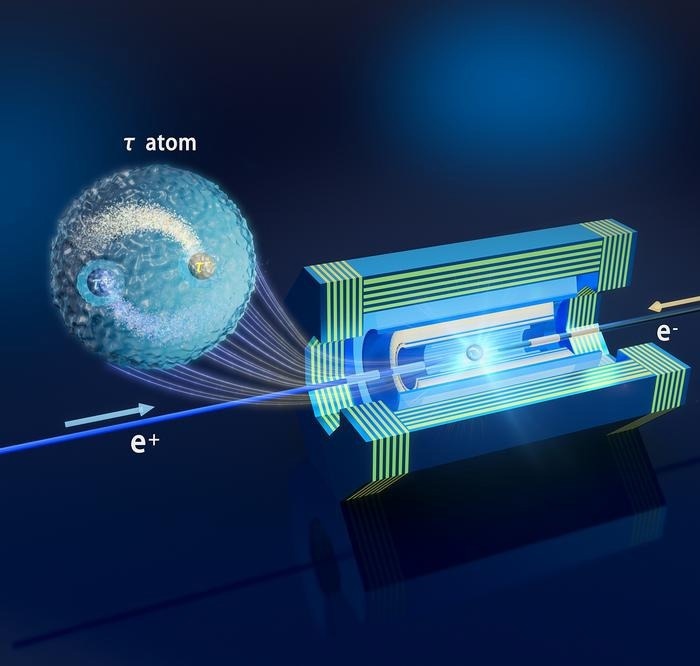A recent study published in Science Bulletin by Science China Press reveals that collecting data up to 1.5 ab-1 at the tauon pair production threshold in an electron-positron collider significantly increases the chances of detecting tauonium. By focusing on signal events that feature charged particles and undetected neutrinos, the probability of observing tauonium can reach a statistical significance greater than 5σ.

The Smallest and Heaviest Atom with Pure Electromagnetic Interaction. Image Credit: ©Science China Press
The hydrogen atom, once viewed as the simplest atomic structure consisting of an electron and a proton, has been superseded by an even simpler form. Recent research has identified atoms composed of structureless particles like electrons (e-), muons (μ-), or tauons (τ-) paired with their corresponding antiparticles. These pairs, held together purely by electromagnetic forces, possess simpler structures than hydrogen. This discovery provides fresh insights into complex scientific domains such as quantum mechanics, fundamental symmetries, and gravity, opening new avenues for exploration and understanding.
To date, only two types of atoms characterized by purely electromagnetic interactions have been identified: the electron-positron bound state discovered in 1951, as reported in Phys Rev (1951;82:455), and the electron-antimuon bound state discovered in 1960, detailed in Phys Rev Lett (1960;5:63). In the 64 years since these discoveries, no additional atoms of this type have been detected, although there are ongoing proposals to search for them using cosmic rays or high-energy colliders.
Tauonium, an atom made up of a tauon and its antiparticle, has a remarkably small Bohr radius of just 30.4 femtometers (1 femtometer = 10-15 meters), which is about 1/1741 the size of the Bohr radius of a hydrogen atom. This small size means that tauonium could be a crucial tool for testing the fundamental principles of quantum mechanics and quantum electrodynamics at much smaller scales. As such, it provides a valuable resource for delving into the mysteries of the micro-material world.
A new strategy for finding tauonium was recently proposed in this study, revealing experimental support for tauonium's existence.
The study further demonstrated that with the same dataset, the tau lepton mass can be measured with extraordinary precision—up to 1 keV, which is two orders of magnitude more precise than the most accurate measurements available from current experiments. This level of precision not only facilitates detailed testing of the electroweak theory within the Standard Model but also has significant implications for addressing fundamental physics questions, such as lepton flavor universality.
Achieving this precision aligns with the key objectives of the proposed Super Tau-Charm Facility (STCF) in China and the Super Charm-Tau Factory (SCTF) in Russia. These facilities aim to operate close to the tauon pair production threshold for one year to discover the smallest and heaviest atom with pure electromagnetic interactions by running the machine near the tauon pair threshold for one year and to measure the tau lepton mass with high precision. Such advancements are expected to enhance our understanding and provide deeper insights into the microscopic world.
Journal Reference:
Fu, J., et al. (2024) Novel method for identifying the heaviest QED atom. Science Bulletin. doi.org/10.1016/j.scib.2024.04.003.